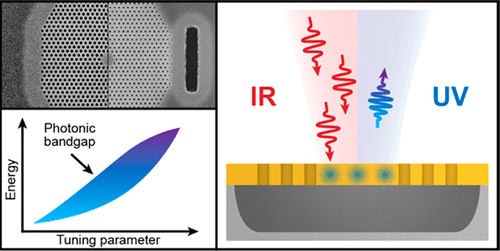当前位置:
X-MOL 学术
›
ACS Photonics
›
论文详情
Our official English website, www.x-mol.net, welcomes your
feedback! (Note: you will need to create a separate account there.)
Tailored UV Emission by Nonlinear IR Excitation from ZnO Photonic Crystal Nanocavities
ACS Photonics ( IF 6.5 ) Pub Date : 2018-03-11 00:00:00 , DOI: 10.1021/acsphotonics.7b01228 Sandro P. Hoffmann , Maximilian Albert , Nils Weber , Denis Sievers , Jens Förstner , Thomas Zentgraf , Cedrik Meier
ACS Photonics ( IF 6.5 ) Pub Date : 2018-03-11 00:00:00 , DOI: 10.1021/acsphotonics.7b01228 Sandro P. Hoffmann , Maximilian Albert , Nils Weber , Denis Sievers , Jens Förstner , Thomas Zentgraf , Cedrik Meier

|
For many applications in photonics, e.g., free-space telecommunication, efficient UV sources are needed. However, optical excitation of such sources requires photons of even higher energies, which are difficult to integrate into photonic circuits. Here, we present photonic crystal devices based on zinc oxide (ZnO) that allow excitation using highly abundant sources in the near-infrared (NIR). These devices offer control of generating tailored photonic modes in the UV range via higher order nonlinear processes by combining the wide electronic band gap and pronounced nonlinear effects in ZnO with the adjustable properties of photonic crystal (PhC) membranes. Two different techniques for fabricating such ZnO-based PhC membranes are discussed, including the presentation of a novel bottom-up approach. Furthermore, dispersive theoretical simulations are introduced to determine the size and position of the photonic band gap, leading to an optimized cavity with only one dominant mode. This is followed by an evaluation of dominant loss channels, comparing cavities for both fabrication techniques, where we implemented a semianalytical model to determine scattering losses at imperfections of the PhCs. Additionally, energetic fine-tuning of such a mode as well as for other photonic modes that are formed by different cavity types is demonstrated. Ultimately, we validate that both linear one-photon and nonlinear three-photon excitation is possible with the presented devices, which renders them potential candidates for efficient UV light emitters that are powered by IR or NIR light sources.
中文翻译:

非线性红外激发从ZnO光子晶体纳米腔产生的量身定制的UV发射。
对于光子学中的许多应用,例如自由空间电信,需要高效的紫外线源。然而,这种源的光激发需要更高能量的光子,这些光子难以集成到光子电路中。在这里,我们介绍了基于氧化锌(ZnO)的光子晶体器件,该器件允许使用近红外(NIR)中的高度丰富的光源进行激发。这些设备通过将宽的电子带隙和ZnO中明显的非线性效应与光子晶体(PhC)膜的可调节特性相结合,提供了通过更高阶非线性过程控制在UV范围内生成定制光子模的控制。讨论了两种不同的制造此类基于ZnO的PhC膜的技术,包括提出了一种新的自下而上的方法。此外,引入色散理论模拟来确定光子带隙的大小和位置,从而产生仅具有一个主模的优化腔。接下来是对主要损耗通道的评估,比较两种制造技术的腔体,我们在其中实施了一个半分析模型,以确定在PhC缺陷处的散射损耗。另外,还展示了这种模式以及由不同腔类型形成的其他光子模式的高能微调。最终,我们验证了所提出的器件可以实现线性单光子激发和非线性三光子激发,这使它们成为由IR或NIR光源驱动的高效UV发光器的潜在候选者。导致只有一个主导模式的优化腔。接下来是对主要损耗通道的评估,比较两种制造技术的腔体,在此我们实施了半分析模型,以确定在PhC缺陷处的散射损耗。另外,还展示了这种模式以及由不同腔类型形成的其他光子模式的高能微调。最终,我们验证了所提出的器件可以实现线性单光子激发和非线性三光子激发,这使它们成为由IR或NIR光源驱动的高效UV发光器的潜在候选者。导致只有一个主导模式的优化腔。接下来是对主要损耗通道的评估,比较两种制造技术的腔体,我们在其中实施了一个半分析模型,以确定在PhC缺陷处的散射损耗。另外,还展示了这种模式以及由不同腔类型形成的其他光子模式的高能微调。最终,我们验证了所提出的器件可以实现线性单光子激发和非线性三光子激发,这使它们成为由IR或NIR光源驱动的高效UV发光器的潜在候选者。在这里我们实施了一个半分析模型,以确定在PhC缺陷时的散射损失。另外,还展示了这种模式以及由不同腔类型形成的其他光子模式的高能微调。最终,我们验证了所提出的器件可以实现线性单光子激发和非线性三光子激发,这使它们成为由IR或NIR光源驱动的高效UV发光器的潜在候选者。在这里我们实施了一个半分析模型,以确定在PhC缺陷时的散射损失。另外,还展示了这种模式以及由不同腔类型形成的其他光子模式的高能微调。最终,我们验证了所提出的器件可以实现线性单光子激发和非线性三光子激发,这使它们成为由IR或NIR光源驱动的高效UV发光器的潜在候选者。
更新日期:2018-03-11
中文翻译:

非线性红外激发从ZnO光子晶体纳米腔产生的量身定制的UV发射。
对于光子学中的许多应用,例如自由空间电信,需要高效的紫外线源。然而,这种源的光激发需要更高能量的光子,这些光子难以集成到光子电路中。在这里,我们介绍了基于氧化锌(ZnO)的光子晶体器件,该器件允许使用近红外(NIR)中的高度丰富的光源进行激发。这些设备通过将宽的电子带隙和ZnO中明显的非线性效应与光子晶体(PhC)膜的可调节特性相结合,提供了通过更高阶非线性过程控制在UV范围内生成定制光子模的控制。讨论了两种不同的制造此类基于ZnO的PhC膜的技术,包括提出了一种新的自下而上的方法。此外,引入色散理论模拟来确定光子带隙的大小和位置,从而产生仅具有一个主模的优化腔。接下来是对主要损耗通道的评估,比较两种制造技术的腔体,我们在其中实施了一个半分析模型,以确定在PhC缺陷处的散射损耗。另外,还展示了这种模式以及由不同腔类型形成的其他光子模式的高能微调。最终,我们验证了所提出的器件可以实现线性单光子激发和非线性三光子激发,这使它们成为由IR或NIR光源驱动的高效UV发光器的潜在候选者。导致只有一个主导模式的优化腔。接下来是对主要损耗通道的评估,比较两种制造技术的腔体,在此我们实施了半分析模型,以确定在PhC缺陷处的散射损耗。另外,还展示了这种模式以及由不同腔类型形成的其他光子模式的高能微调。最终,我们验证了所提出的器件可以实现线性单光子激发和非线性三光子激发,这使它们成为由IR或NIR光源驱动的高效UV发光器的潜在候选者。导致只有一个主导模式的优化腔。接下来是对主要损耗通道的评估,比较两种制造技术的腔体,我们在其中实施了一个半分析模型,以确定在PhC缺陷处的散射损耗。另外,还展示了这种模式以及由不同腔类型形成的其他光子模式的高能微调。最终,我们验证了所提出的器件可以实现线性单光子激发和非线性三光子激发,这使它们成为由IR或NIR光源驱动的高效UV发光器的潜在候选者。在这里我们实施了一个半分析模型,以确定在PhC缺陷时的散射损失。另外,还展示了这种模式以及由不同腔类型形成的其他光子模式的高能微调。最终,我们验证了所提出的器件可以实现线性单光子激发和非线性三光子激发,这使它们成为由IR或NIR光源驱动的高效UV发光器的潜在候选者。在这里我们实施了一个半分析模型,以确定在PhC缺陷时的散射损失。另外,还展示了这种模式以及由不同腔类型形成的其他光子模式的高能微调。最终,我们验证了所提出的器件可以实现线性单光子激发和非线性三光子激发,这使它们成为由IR或NIR光源驱动的高效UV发光器的潜在候选者。











































 京公网安备 11010802027423号
京公网安备 11010802027423号